You'll find a lot of familiar features as you make the switch from Skype for Business to Microsoft Teams—plus a few new things we hope you'll like!
Here's a short breakdown of the similarities and differences between Skype for Business and Teams.
| Task | Skype for Business | Microsoft Teams |
|---|---|---|
| Chat (IM) | ||
| | |
| | |
| | |
| | |
| | |
| | |
| | |
| | |
| Meetings | ||
| | |
| | |
| | |
| | |
| | |
| Calls | ||
| | |
| Mobile | ||
| | |
Plus Teams offers...
-
Teams and channels for tracking projects, conversations, files, and meetings all in one place.
-
Customizable apps and bots.
-
@mentions to get someone's attention.
An IM in Skype for Business is called a chat in Teams. In Teams, you can add flavor with emoji, GIFs, and memes and even convert a chat into an audio or video call! In addition, Teams offers persistent chat, so you can find and resume any conversation.
Find a contact and start a chat
-
Go to the command box at the top of the app.
-
Type the name of the person you want to find.
-
Select the name from the list.
-
At the bottom of the screen, compose your chat message and press Enter.
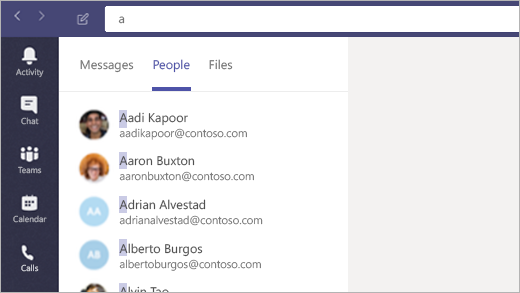
Make Teams the default chat app for Office
Do this to make sure that your presence info (Available, Busy, In a meeting) shows up in Outlook and other Office apps.
-
Select your profile picture at the top of Teams, then Settings.
-
Select General > Register Teams as the chat app for Office (requires restarting Office applications).

Add someone to a chat
-
From the chat, click Add people
 .
. -
Type the names of the people you want to add, and then click Add.
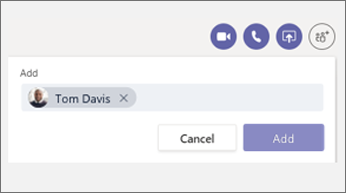
Have fun with emoji, GIFs, and memes
-
Go to the compose box at the bottom of your chat or channel conversation.
-
Beneath the compose box, do one of the following:
-
Click Emoji
 to select the perfect face from the gallery.
to select the perfect face from the gallery. -
Click GIF
 to search for an animated GIF.
to search for an animated GIF. -
Click Sticker
 to go to our galleries of customizable memes and stickers.
to go to our galleries of customizable memes and stickers.
-
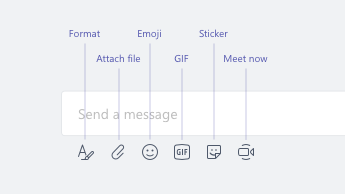
Turn a chat into an audio or video call
Just like in Skype for Business, you can turn a chat into a call in Teams:
From your existing chat, click Video call  or Audio call
or Audio call  at the top of the screen.
at the top of the screen.

Resume an old conversation
In Teams, you can find and resume a previous conversation. No matter how many times you've spoken to that person, it's all in one place.
-
To search for old messages (or people, chats, and files), use the command box at the top of your screen.
-
Click the conversation you want to continue.
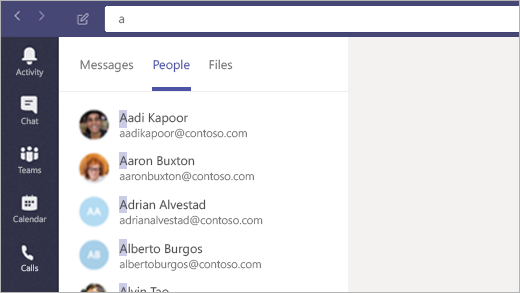
Respond to a chat
When someone sends you a chat, the Teams icon in your taskbar lights up with a number in a red circle. To review and respond:
-
Open Teams.
-
Click Chat
 on the left side of the app.
on the left side of the app. -
Your active chats are highlighted in bold.

Want to learn more about chat? Visit the Microsoft Teams help center.
Like Skype for Business, you can schedule and host online meetings in Teams, as well as manage chat and people from your meeting window. Even better, meetings are part of your Teams interface, keeping all contacts, conversations, calls, and meetings in one place.
Schedule a meeting from Outlook
-
Open Outlook and go to the calendar view.
-
Click New Teams Meeting at the top of your view.
-
Invite people, add meeting details, and click Send.
People outside your organization can use a guest account or join the meeting anonymously.
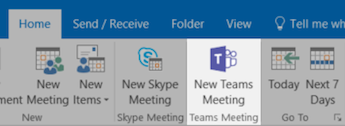
Join a meeting
There are many ways to join meetings in Teams:
-
From your Outlook calendar or from an Outlook reminder that pops up.
-
In Teams, click Calendar
 on the left side of the app. Find the meeting and click Join.
on the left side of the app. Find the meeting and click Join.
Join meeting audio
After you click Join in Teams, you can choose how you get audio.
Teams automatically tries to connect to your computer headset or speakers. Alternatively, you can dial in using the phone number (if provided in the meeting invite).
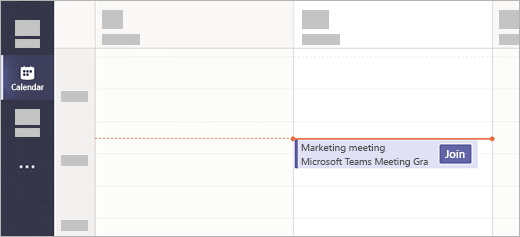
Share your desktop in a meeting
-
To share your screen, a specific app, or a file in a meeting, click Share desktop
 in your meeting controls.
in your meeting controls. -
While sharing, click Give Control at the top of the screen to hand the reins over to someone else. Click Cancel Control to take them back.

Manage your meeting
In a meeting, go to meeting controls and do one of the following:
-
Click Show conversation
 to chat with people during a meeting.
to chat with people during a meeting. -
Click Show participants
 to see the roster, where you can add, remove, or mute people.
to see the roster, where you can add, remove, or mute people. -
Click More actions
 to locate additional functions including device settings and recording.
to locate additional functions including device settings and recording.

Still curious about meetings? Visit the Microsoft Teams help center.
Just like Skype for Business, Teams can also serve as your office phone. From one-click speed dialing to a standard dial pad to accessing voicemail, Teams offers all of your calling needs at your fingertips.
Make a call
Call from a chat
-
Go to the command box at the top of the app and type someone's name.
-
Select the person to start a chat.
-
At the top of the chat, click Video call
 or Audio call
or Audio call  .
.
Call one of your contacts
-
Click Calls
 on the left side of the app.
on the left side of the app. -
Click Contacts.
-
From the person's profile card, click Video call
 or Call
or Call  .
.
Direct dial someone
-
Click Calls
 on the left side of the app.
on the left side of the app. -
Click Make a call.
-
Enter the person's number on the dial pad.
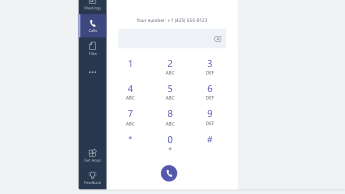
Add someone to a group call
For right now, this feature only works for calls that start as group calls.
-
Click Show participants
 in the top right corner of your screen.
in the top right corner of your screen. -
Type the person's name or phone number to add them to the call.

Use audio controls
-
In a call, click More actions
 in the calls control menu and select Show device settings.
in the calls control menu and select Show device settings. -
Use the menus to select the speaker, microphone, and camera options you want.

Forward calls
-
Click your profile picture at the top of the app.
-
Select Settings > Calls.
-
Under Call answering rules, choose Forward my calls.
-
Select where you want your forwarded calls to go.
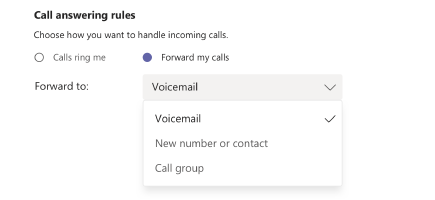
Answer a call
Whenever you get a call in Teams, you'll receive a notification.
-
Click Accept video call
 to enable video.
to enable video. -
Click Accept audio call
 to answer with audio only.
to answer with audio only. -
Click Decline call
 to go on with your day.
to go on with your day.

Check voicemail
-
Click Calls
 > Voicemail.
> Voicemail. -
Select a voicemail from the list.
-
Use the playback controls to listen or read the transcript.
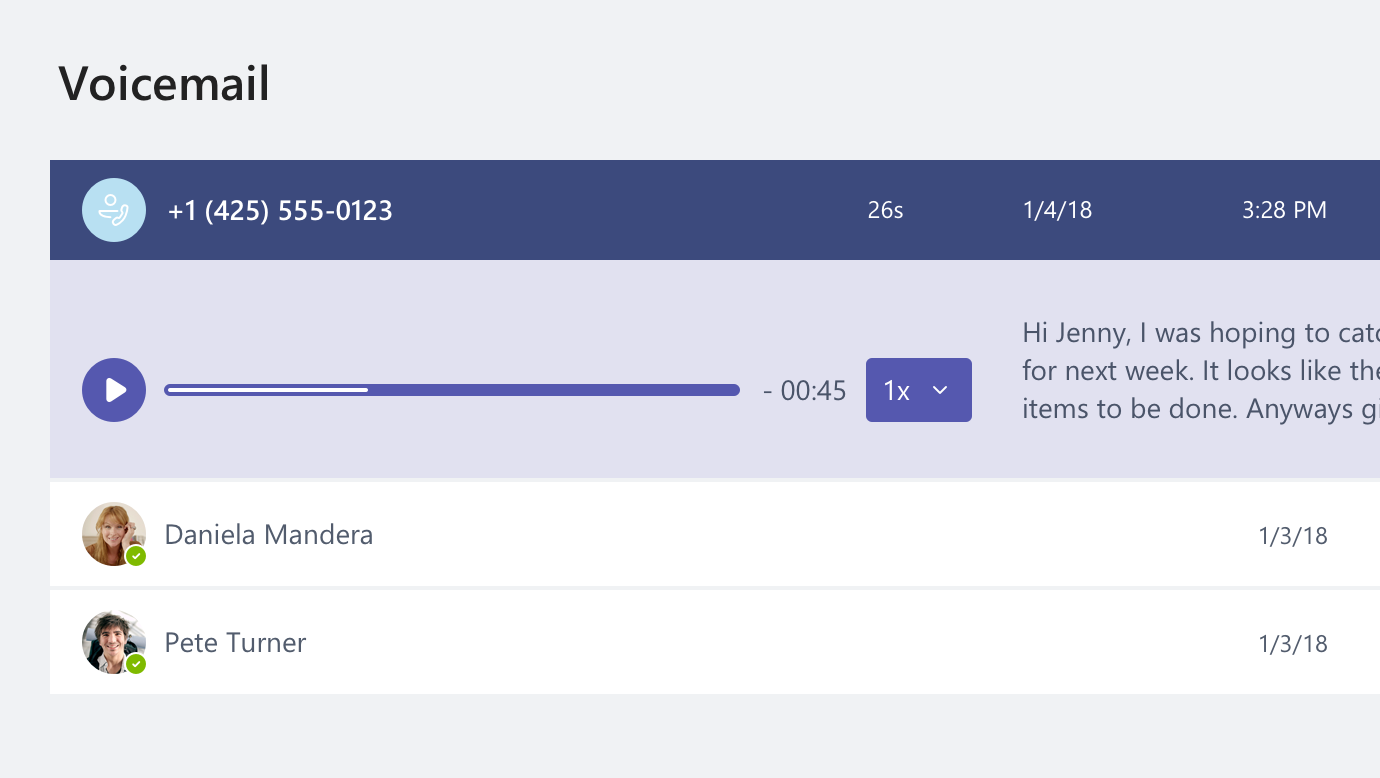
Got more questions about calls? Visit the Microsoft Teams help center.
Try Teams on the go! Sign in to Teams on your mobile device to chat, call, join meetings, and more, wherever you are. Download the mobile app.
Manage profile options
-
Tap More
 at the top of the screen.
at the top of the screen. -
Tap your status to change it.
This updates your status on all your devices that run Teams, including your computer.
-
Tap Settings to change your profile options.
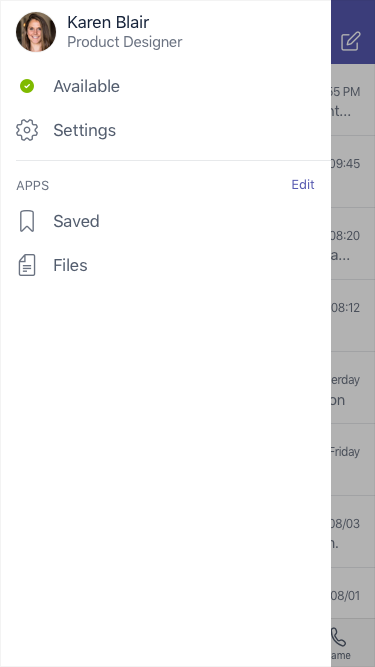
Send a message and make a call
-
Tap Chat
 .
. -
Tap New chat
 at the top of the screen.
at the top of the screen. -
Type a name or names in the To field.
-
Type your message and tap Send
 .
. -
To turn your chat into a call, tap Video call
 or Audio call
or Audio call  at the top of the screen.
at the top of the screen.
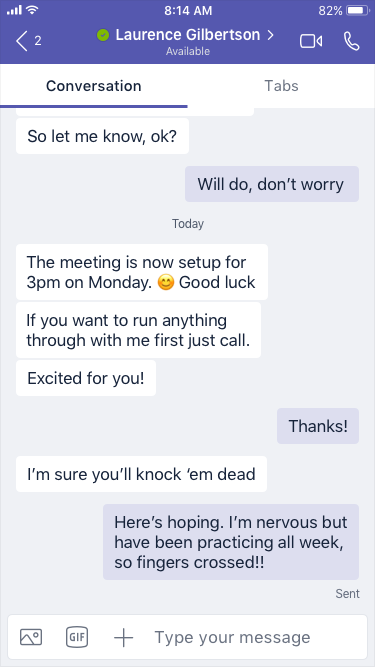
Make a direct call
-
To call someone directly, tap Calls
 > Dial pad
> Dial pad  and enter a phone number in the dial pad.
and enter a phone number in the dial pad. -
To call a contact, tap Calls
 > Contacts
> Contacts  and select a contact.
and select a contact.
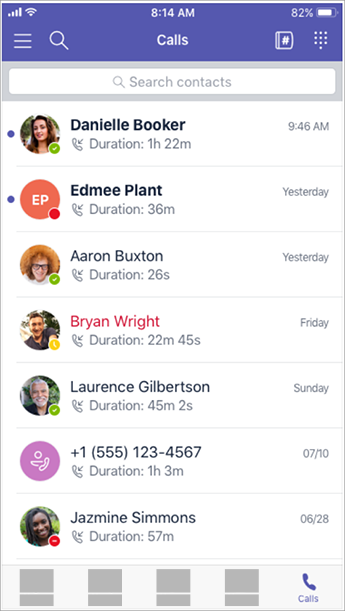
Answer a call
When a call comes in to Teams, a notification pops up, letting you know. Tap Answer  (the blue one!) to start talking.
(the blue one!) to start talking.
Join a meeting
-
Tap Calendar
 to go to your calendar. Find the meeting and tap Join.
to go to your calendar. Find the meeting and tap Join. -
Tap Join from a meeting notice in a channel or chat.
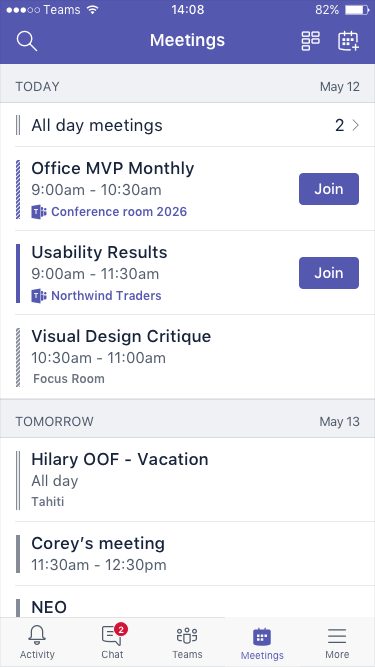
Want to learn more about using Teams on your mobile device? Visit the Microsoft Teams help center.
When I try to sign in to Skype for Business, I see a message saying that Skype for Business has been upgraded to Microsoft Teams. What does this mean?
Your organization has upgraded to Microsoft Teams. While you'll still be able to edit, cancel, or join existing Skype for Business meetings, you won't be able to use Skype for Business to chat, make calls, or create new meetings. Teams has many of the same meetings, calling, and chat capabilities that you're used to. Look on the Chat (IM), Meetings, and Calls tabs in this article to get familiar with how to do these things in Teams. For questions around the upgrade itself, contact your help desk or refer any to resources that your organization provided.
What happens to my existing Skype for Business meetings?
Skype for Business meetings that were scheduled before the upgrade are still in your Outlook calendar and will be hosted in Skype for Business. Online meetings that you create once your organization has upgraded will be hosted in Teams. In both cases, join the meeting by clicking the link in the Outlook meeting invite and following the prompts.
How do I change options for an existing Skype for Business meeting?
To change the time, location, title, subject, or attendees list, open the meeting from your Outlook calendar and make changes as usual. To change other options like lobby activity, presenters, and more, do the following:
-
Before the scheduled start time, open the meeting from your Outlook calendar and click the link to join.
-
Once in the meeting, click More Options
 > Skype Meeting Options. Make the changes you want, then click OK. (Make sure you're using the Skype for Business desktop app—you won't be able to make these changes in Skype Web App.)
> Skype Meeting Options. Make the changes you want, then click OK. (Make sure you're using the Skype for Business desktop app—you won't be able to make these changes in Skype Web App.)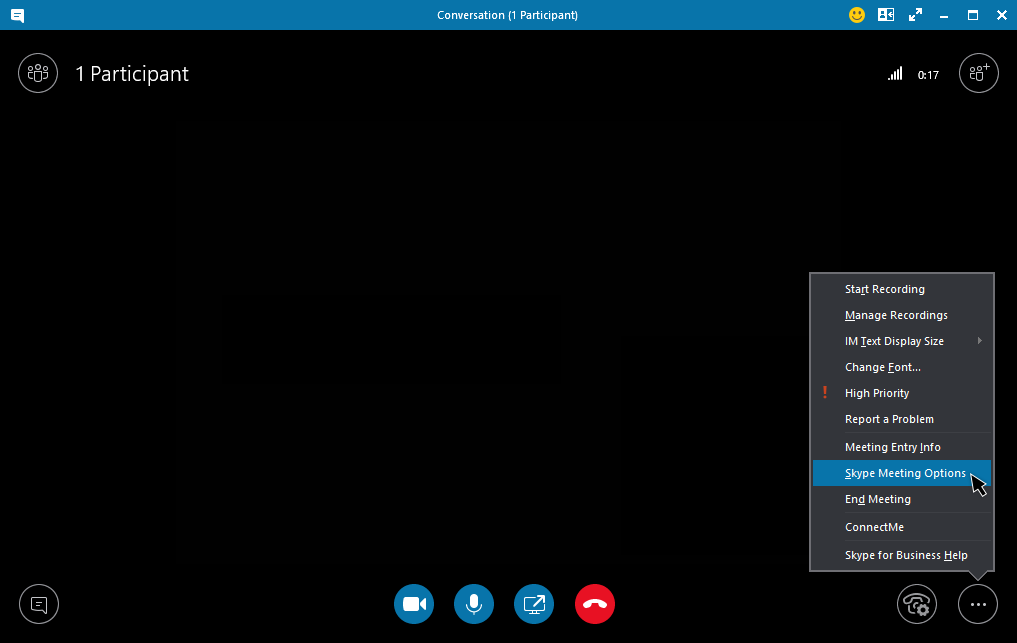
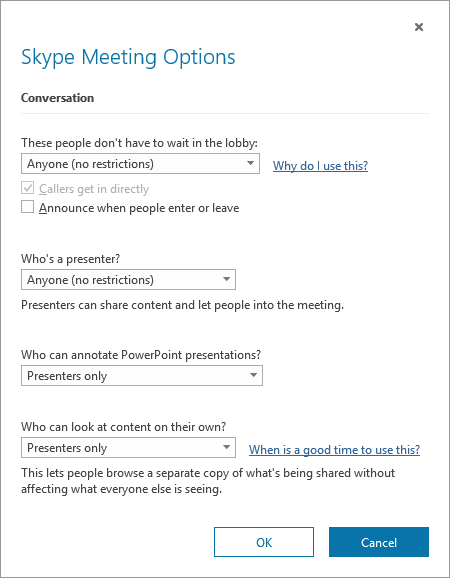
-
To change options for participants, click Open Participant Pane > Participant Actions.
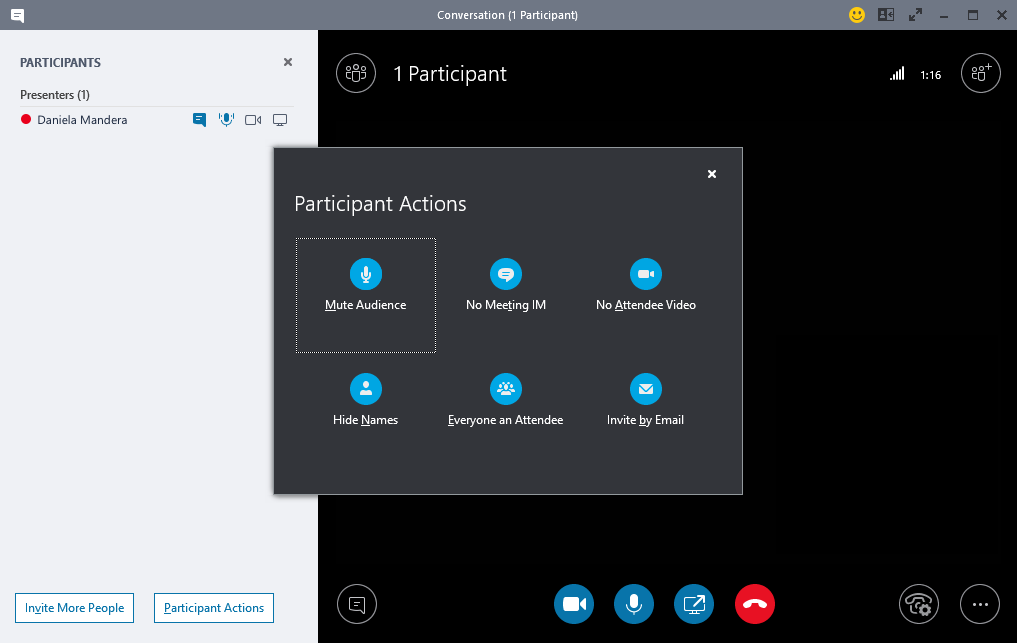
Note: To change an existing Skype for Business meeting into a Teams meeting, you'll need to set the meeting up again. For info, see Set up a meeting.
-
To change audio and video devices used during the meeting, click Call Controls > Devices.
Where do I find my past Skype for Business conversations, calls, or voicemails?
You'll be able to find these if your organization had the Conversation History feature enabled in Skype for Business. The easiest way to find them is to open Outlook, then go to the Conversation History folder.
Are my Skype for Business contacts and contact groups in Teams?
Yes. In Teams, click Chat on the left. You'll see two tabs at the top—Recent and Contacts. Your Skype for Business contacts and contact groups are on the Contacts tab. Click More options  next to a contact or contact group to see what you can do.
next to a contact or contact group to see what you can do.
Where can I learn more about how to use Teams?
There are a couple of ways. The Teams help center has training courses and lots of how-to info. When you're in Teams, you can click your profile pic, then Help, to see similar how-to info and chat with our bot.

Microsoft Office Tutorials: Switch To Teams From Skype For Business >>>>> Download Now
ReplyDelete>>>>> Download Full
Microsoft Office Tutorials: Switch To Teams From Skype For Business >>>>> Download LINK
>>>>> Download Now
Microsoft Office Tutorials: Switch To Teams From Skype For Business >>>>> Download Full
>>>>> Download LINK es